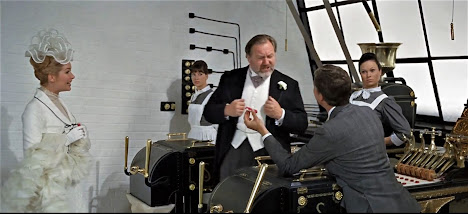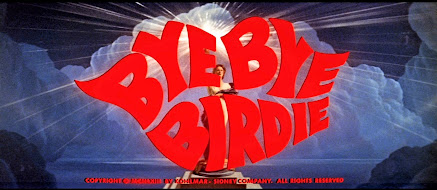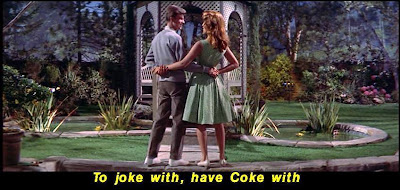Last year, whenever I came across a review complaining about the 3½-hour running time
of Martin Scorsese's The Irishman (2019), my first thought was that none of these folks would have survived being a kid in the 1960s. Not at a time when Hollywood's most eagerly-anticipated family movies all wore their lengthy running
times like emblems of prestige: Mary Poppins (1964): 2hr 20m; The
Sound of Music (1965): 2hr 55m; Doctor Dolittle (1967): 2hr 32m; Thoroughly Modern Millie (1967): 2hr 33m; and
Oliver! (1968): 2hr 33m.
And certainly not at a time when double-features were the norm, and
theaters, under the guise of presenting "Top Family Entertainment," offered
child-abuse programming like pairing the 2hr 25m Chitty Chitty Bang Bang with
the 3hr 4m Around the World in 80 Days (1956). Such was the
bladder-challenging bill at San Francisco's Castro Theater in the summer of
1969 when I was 11-years-old and saw Chitty Chitty Bang Bang for the first time.
 |
| Click image to enlarge |
Most roadshow films went immediately into wide release after their exclusive engagements were over (Continuous Performances! Popular Prices!), but the underperforming Chitty Chitty Bang Bang was swiftly yanked from screens after its poorly-reviewed initial run (The SF Examiner called it "abysmally saccharine"), re-emerging six months later as a get-the-kids-from-underfoot summer release in August of 1969. But by then, it was too late. Over the Easter holidays, America's fickle kiddie population had fallen in love with another four-fendered friend…Herbie, the matchmaking Volkswagen Beetle of Disney's The Love Bug. A case of love at first sight that saw the modest feature earning more than ten times its $5 million budget at the boxoffice while the heavily-promoted Chitty Chitty Bang Bang remained unable to recoup its $12 million budget.
 |
| Dick Van Dyke as Caractacus Potts |
 |
| Adrian Hall and Heather Ripley as Jeremy & Jemima Potts |
 |
| Lionel Jeffries as Grandpa Potts |
Chitty
Chitty Bang Bang
is the only children's book written by James Bond creator Ian Fleming. It's
also the only non-Bond film made by James Bond franchise producer Albert R. Broccoli.
Fleming's slight story of a family and their magical car was made into a grand-scale
movie musical (at the time, the most expensive musical ever made in
England) that is commonly (and accurately) described these days as a James Bond film for children.
This is certainly true of its story, which pits a good guy devoted to gadgetry (crackpot inventor Caracticus Potts) and a woman with an outrageous name (candy heiress Truly Scrumptious) against an eccentric villain (Auric Goldfinger himself, Gert Fröbe as Baron Bomburst). But the Bond connection also applies to the production team, many of whom began work on CCBB fresh from completing the latest Bond film You Only Live Twice (1967). The screenplay for the Bond film was written by Chitty Chitty Bang Bang screenwriter Roald Dahl (with director Ken Hughes). Both Hughes and CCBB's Baroness Bomburst Anna Quayle, had just finished work on the Bond spoof Casino Royale (1967).
 |
| Desmond Llewelyn, as garage owner Mr. Coggins. Llewellyn portrayed "Q" in a staggering 17 James Bond films. |
But in 1968, the movie Chitty Chitty Bang Bang most eagerly sought to emulate was Disney's blockbuster Mary Poppins (1964). And if imitation is the sincerest form of flattery, then Chitty Chitty Bang Bang was so sincerely devoted to flattering Mary Poppins that it all but followed a blueprint. Same songwriters (Robert and Richard Sherman Sherman); same choreographers (Mark Breaux & Dee Dee Wood); same period (the book's contemporary setting was changed to Mary Poppins' Edwardian era); same casting (Poppins' Dick Van Dyke—mercifully, minus the English accent), and a Julie Andrews substitute (Sally Ann Howes). I've read that the producers sought to reunite Mary Poppins co-stars Julie Andrews & Dick Van Dyke. But unless the role of Truly was conceived as being significantly larger than its present incarnation, I find it difficult to believe Julie Andrews--a headlining Oscar winner at this stage--ever seriously entertained the idea of playing second lead to the actor who was her supporting co-star in her very first picture.
But Hollywood wishes do come true, and when released, Chitty Chitty Bang Bang did indeed have critics comparing it to Mary Poppins…unfavorably on all counts. In his memoirs, even star Dick Van Dyke joined the chorus, citing that he felt Hughes was the wrong director for the job and that the film ultimately failed to capture the magic of Disney's classic. Given that Ken Hughes would go on to direct the Mae West travesty Sextette (1978), perhaps Van Dyke has a point. Falling short of its fantasmagorical expectations, Chitty Chitty Bang Bang joined the ranks of Camelot (1967) and Paint Your Wagon (1969) as representative of a form of "Bigger is Better" filmmaking whose era was nearing its end. But time has been kind, and in the 50-plus years since its release, Chitty Chitty Bang Bang has emerged from the shadow of Mary Poppins enough to be hailed as a beloved children's classic judged and appreciated on its own considerable merits. A far cry from the days when my attempts to recommend the movie to schoolmates were met with chants of "Shitty Shitty Bang Bang."
 |
| Anna Quayle and Gert Frobe as Baroness & Baron Bomburst of Vulgaria |
Seeing Chitty Chitty Bang Bang for the first time
on a double-bill with Around the World in 80 Days was quite
the thrill and nowhere near the backache challenge for my 11-year-old self as I
would find it today. Though I confess to having fallen asleep during part of Around
the World in 80 Days (one moment Shirley MacLaine hadn't yet entered
the movie, the next, there she was in that balloon), by and large, as long as
the Jujyfruits and popcorn held out, I was a happy camper.
The only big musical I'd seen at this point was Thoroughly Modern Millie (1967), so without prior visions of Mary Poppins dancing in my head, I thought Chitty Chitty Bang Bang was the most extraordinary movie I'd ever seen. I was utterly wowed and enchanted by it. On an enormous screen and with glorious stereophonic sound Chitty Chitty Bang Bang was a storybook fantasy adventure come to life. It seemed to have everything: action, laughs, chases, comic schtick, rousing songs, zany characters, romance, dance, spectacle, and a big wooly sheepdog named Edison. It even had a bit of a dark side.
I remember being very taken with Potts' kooky Rube Goldberg-style inventions (the work of Frederick Rowland Emett), particularly that ingenious breakfast-making machine I still would love to own. But what stands out most memorably is the titular automobile itself. Designed by Academy Award-winning production designer Ken Adams under what must have been no small degree of pressure to live up to the laundry list of glowing superlatives ascribed to it in the title song, the magical car dubbed Chitty Chitty Bang Bang is every bit the iconically miraculous motorcar the movie needed it to be.
Critics were tough on the film for what they asserted were disappointingly primitive special effects for a movie of this size and expense (they may have had a point, as Chitty's budget was equal to or larger than that of another 1968 release, Stanley Kubrick's 2001:A Space Odyssey whose special effects had set a new standard), but back then I didn't notice or didn't care. When Chitty turned into a boat, or the first time it took wing, just the sight of it (crude special effects and all) hit a fanciful, fantasy nerve in me. I remember getting such a goosebump charge out of it.
THE STUFF OF FANTASY
I saw Chitty Chitty Bang Bang two more times that summer, by then paired with Heaven with a Gun, a truly awful Glenn Ford western made bearable only by its being half the running time of Around the World in 80 Days. And in all these years, my love of it as a cheerful, brightly-colored confection as sweet and loaded with empty calories as anything whipped up by the Scrumptious Sweet Company, has only increased. I say empty calories because Chitty Chitty Bang Bang is a delectable film that, for all its whimsy and charm, has always engaged my spirits more than my heart. The story—essentially a kidnap/rescue adventure fantasy—is fun in a cartoon kind of way…full of activity and "business" meant to entertain and amuse. But the screenplay keeps the characters at a bit of a remove, their personalities and goals presented so cursorily that the movie never touches me or gives me waterworks in the manner of The Wizard of Oz, Mary Poppins, or Willy Wonka and the Chocolate Factory.
Maybe my dry eyes are because, as children's movies go, Chitty Chitty Bang Bang's emotional stakes are kept on a low boil. Both The Sound of Music and Mary Poppins saw lonely children reclaiming their fathers thanks to the spunky intervention of Julie Andrews, and in Oliver!, a severely brutalized and exploited orphan finds a home. But Chitty Chitty Bang Bang presents us with a cast of characters whose lives may not be perfect when the film begins, but are far from unhappy. Caractacus is a widowed fantasist whose inventions come to naught, but his loving children's belief in him is unshakable. And I couldn't have been the only kid who thought Jemima & Jeremy had it pretty sweet living with minimal parental supervision out there in the country in a picturesque windmill crammed with toys and gadgets made by a fun dad.
Even Jemima & Jeremy's quest to rescue the junked Chitty from the fiery furnace is a low-wattage conflict due to the notion of Chitty being a sentient machine is never fully developed (she shivers at the mention of being melted and rescues the family at moments of danger, but has no personality to speak of) not mention the kids are ready to abandon their salvage mission when it appears doing so will cause their dad undue hardship. However, one thing the film gets right is granting the frosty Truly Scrumptious character a thawing-out musical number with the children. What's ideal about the casting of Sally Ann Howes is that she's pretty in precisely the way a child can relate to...like a teacher one develops a crush on. By the end of the number, it's been firmly established that Jeremy & Jemima need a mom, and we in the audience can identify with them in their wish for Truly and their dad to fall in love.
 |
| Benny Hill as The Toymaker |
WHAT
I LOVE ABOUT THIS FILM
I didn't like movie musicals very much when I was young. No fewer than 13 musicals were released in 1968 (3 by Elvis alone!). To this day, I could kick myself for passing opportunities to see current favorites like Funny Girl, Finian's Rainbow, and Star! in their original release. But what I did like were cars. Toy cars, model cars, and, after seeing the 1967 theatrical re-release of The Absent-Minded Professor (1961), flying cars. Fred MacMurray's flying Flubbermobile captivated me to no end, so when Chitty Chitty Bang Bang came on the scene, the car was the primary attraction for me. Nowadays, my absolute favorite things about Chitty Chitty Bang Bang are its songs and musical sequences. The eleven songs by Robert and Richard Sherman (showcased by Irwin Kostal's brilliant orchestrations) are catchy and hummable and have aged remarkably well. Not a clunker in the bunch; the entire original score is splendid...even the dreaded "The Roses of Success" has started to grow on me.
Emmy Award-winning TV star Dick Van Dyke had the opportunity to display his versatility as an actor, dancer, and singer in several iconic movies. He made his film debut opposite Janet Leigh in Bye Bye Birdie (1963), his likable persona transferring easily to the big screen.
I'd allowed a lot of time to pass between viewings of Chitty Chitty Bang Bang, this recent revisit stirring up dust clouds of nostalgia of such density as to fairly obscure my awareness of what I might have once characterized as the film's flaws. Chitty Chitty Bang Bang hasn't changed, but in the last few years, my appreciation of the value of good, old-fashioned schmaltz, cornball comedy, and sweet-natured sentimentality has. One doesn't have to try very hard to draw contemporary parallels to Chitty Chitty Bang Bang's child-caging Vulgarians and the tyrannical, childishly petulant, tantrum-throwing Baron Bomburst. And indeed, it's for that very reason that Chitty Chitty Bang Bang's liveliness, tuneful good cheer, and elemental, storybook sweetness (and silliness) proved to be just the right "happy endings" spoonful of sugar medicine I needed to make the waning days of 2020 a little easier to deal with. (There go those Mary Poppins comparisons, again!)
 |
| Ballet star Robert Helpmann (The Child Catcher) with Moira Shearer in The Red Shoes (1948) |






































